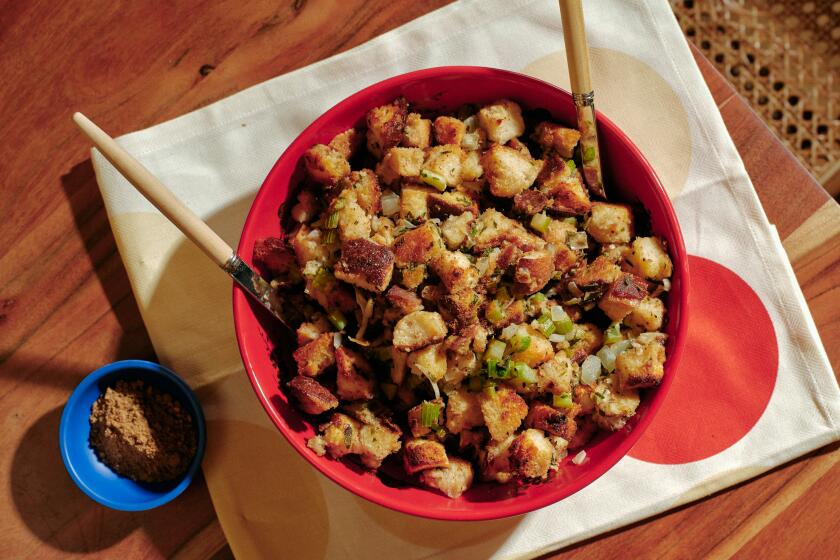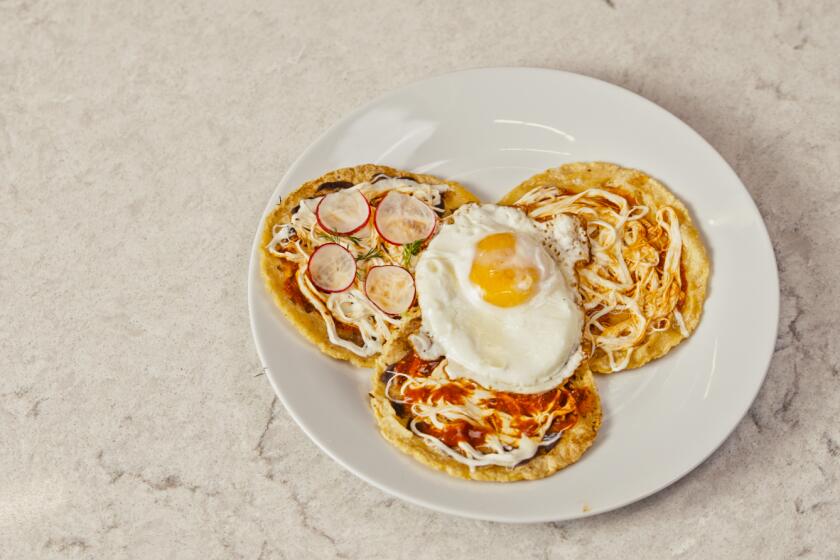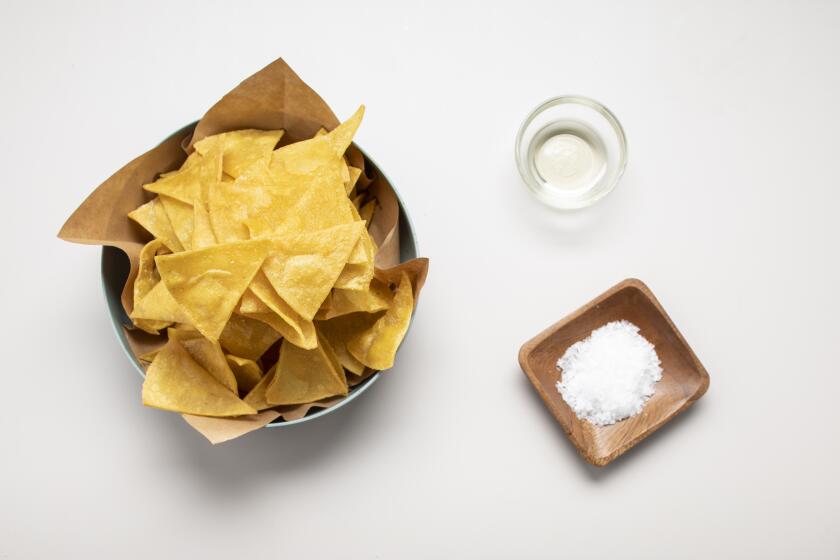Hominy muffins
- Share via
Among the events commemorating Black History Month this year is the publication of three new books celebrating the rich and varied culinary contributions of African Americans.
“Good Things to Eat, as Suggested by Rufus,” is a reissue of the first cookbook by an African American chef, Rufus Estes. In her second book, “Cooking the Gullah Way: Morning, Noon, & Night,” Sallie Ann Robinson continues to document the cuisine and culture of the Gullah, former African slaves isolated for years along the Eastern coastal shores from the Carolinas to Florida. Patty Pinner’s “Sweety Pies: An Uncommon Collection of Womanish Observations, With Pie” collects recipes for an enticing variety of pies and presents them with mini-profiles (of the pies’ originators) and kitchen folklore.
“Good Things to Eat,” originally published in 1911, begins with a brief autobiography, describing how Estes, born into slavery in 1857, rose to be a chef for the Pullman Private Car Service and later a world-traveled private chef. During his tenure with Pullman, he prepared lavish meals for presidents, celebrities, dignitaries and royalty. His recipes range from the haute cuisine of the day to rustic, informal dishes and baked goods. Many are unusual (not to mention impractical) from today’s standpoint; one for truffled turkey calls for 3 to 4 pounds of truffles -- imagine paying for that many truffles nowadays!
As with other cookbooks of the time, recipes are in paragraph form and require a level of proficiency from the user. The recipe for a potato mold calls for “some potatoes” to be mixed with “some butter” and a “little” milk, before adding “enough chopped parsley to make it look pretty.” And instructions often indicate simply a moderate, hot, or “rather quick” oven. But you can cook from them.
Of the recipes we tested, the favorite was hominy muffins. It took a little creativity to determine the heat, timing and muffin pan size, but the resulting muffins were light and flavorful, not too sweet, and the big kernels of corn throughout were a wonderful touch.
“Cooking the Gullah Way” follows the rhythm of a typical day on Daufuskie Island, which was fairly isolated until the mid-20th century. The book immerses the reader in this culture through Robinson’s personal stories and family recipes. Robinson includes sections on canning and preserving, winemaking, and on folk beliefs and home remedies.
Interspersed throughout are 75 recipes, most drawing on local ingredients such as the abundant seafood, and often creatively making use of everything on hand (several dishes are flavored with pigs’ tails). Although much more detailed than Estes’ cookbook, many recipes still rely on reader intuition with instructions such as “cook until done as you like” or “tender as you like.” Yield is an issue. The recipe for flounder full of crabmeat calls for two flounder, but the crabmeat stuffing makes enough to fill at least 10 fish. And number of servings are not indicated, so the reader has to rely on experience to guess whether a recipe will feed two or 20.
Otherwise, these recipes are relatively simple and easy to follow and effectively highlight the ingredients. The emphasis is on shrimp in a sandwich of fried shrimp with lettuce and tomato. Large, sweet Eastern shrimp seasoned with salt, pepper, garlic and paprika before flouring are fried in onion-infused oil and have a wonderful medley of flavors. The onion flavor gently permeates the crunchy crust, and the moist shrimp inside has a mild kick from garlic and paprika. Instructing the reader to get a good grip on the hearty sandwich, Robinson writes, “Take a big bite and love the goodness.”
Pinner follows the success of her first book, “Sweets: A Collection of Soul Food Desserts and Memories,” with her new book “Sweety Pies.” Like her first, this collection of recipes is intertwined with stories and anecdotes. It is an entertaining read, frustrating only in that you’re torn between wanting to curl up to read the book cover to cover and wanting to run into the kitchen to make each pie as its recipe unfolds.
Tossing in the unexpected
The recipes are divided into categories: berry pies, cereal pies, cream and custard pies, fruit pies, nut and vegetable pies, and meringue pies. The pies range from the familiar such as pecan or apple, to the unfamiliar, including cornflake and grated carrot.
Walnut-raisin pie from Elizabethtown starts with a wonderful pecan pie-like custard base, but instead of going with the more traditional nut, Pinner folds walnuts and raisins into the filling and spices the pie with orange zest and nutmeg. “Strawberry Hand Pies” combine simply incredible flaky fried crusts with sweet, fresh strawberry filling. There seems to be no end to Pinner’s creativity or resourcefulness with ingredients as she walks the reader through instructions for navy bean custard pie, butterscotch pie with meringue topping, Key lime pie and many more.
Each of these cookbooks illustrates a rich culinary heritage from a different starting point: revisiting the recipes of a historically significant chef, delving into a regional culture, or exploring the endless variations of a beloved dessert. And, when you cook -- and eat -- from the recipes they pass down, you’re living the legacy.
Heat the oven to 350 degrees. Grease a 10-muffin pan (or enough mini-muffin pans for 30 mini-muffins) and set aside.
In a large bowl, sift together the flour, baking powder, sugar and salt. Set aside.
In a medium bowl, stir together the hominy, butter and milk. Whisk in the eggs. Stir the liquid ingredients into the dry ingredients just until combined.
Fill the greased muffin pans three-fourths full with batter and place in the oven. Bake the muffins until golden and a toothpick inserted in the middle comes out clean; about 25 minutes for standard muffins (18 to 20 minutes for mini-muffins). Cool the pan on a rack before removing the muffins. The muffins will keep for 3 to 5 days, stored in a sealed plastic bag at room temperature.
Get our Cooking newsletter.
Your roundup of inspiring recipes and kitchen tricks.
You may occasionally receive promotional content from the Los Angeles Times.
















